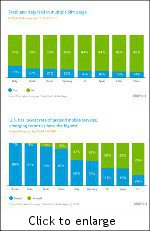In August last year when India’s fifth largest GSM service provider Aircel commercially launched its mobile application store PocketApps for its post and prepaid subscribers across India, it ventured into a territory in which other Indian telecom service providers had scant presence.
During that time, the App store segment was witnessing action from platform providers such as Apple and Android; and handset manufactures such as Nokia and BlackBerry, and Indian telcos were not excited about apps as they were concentrating more on voice and value added services such as music, Bollywood, cricket and astrology content.
Aircel was the first operator to launch an application store in partnership with Infosys for its subscriber’s across all platforms and handsets. PocketApps was the fourth app store in the country. Nokia launched its Ovi Store in May 2009 and BlackBerry brought its app store to India in November 2009. Before these, Apple’s App Store for iPhone users was already in existence. Bharti Airtel had also launched an app store, but it was only for Android phones, and was built in collaboration with CanvasM.
Reflecting on Aircel’s initiative, Gurdeep Singh, chief operating officer of the company, says, “When we launched an app store, we wanted to introduce the concept of apps and their utility to our subscribers.”
“Within two months our subscribers will see the new look of our app store, which will have all the apps that an Indian user will desire. It will be a one stop solution for all the app related queries of our customers,” Singh added.
PocketApps charges
Aircel subscribers can download free and paid applications from PocketApps using multiple channels such as GPRS, WAP and SMS.
These applications are available for a wide variety of makes and models of mobile phones unlike many other stores that are locked to a particular platform such as Android and Apple, or to a particular handset brand such as Nokia.
Access to PocketApps is free via Aircel’s Pocket Internet card and for its unlimited GPRS plan subscribers, while for other post and prepaid subscribers it is accessible for Rs 7 per week or at Rs 2 for a day.
Aircel customers can download as many free apps as they want, or choose from lots of paid mobile applications, at a nominal price, for which the charges are either debited from prepaid balance or charged to the postpaid bill. There is also a free subscription option that allows the user to access the PocketApps store for three days over a period of one year.
Aircel’s spokesperson did not reveal the number of apps in the store but said that it has something for all segments, be it the youth, housewives, professionals, children, or the elderly.
Application categories
Currently, seven categories of applications are available at PocketApps. These are Everyday Convenience, Education and Career, Finance, Health and Living, Games, Music and Fun, and Social Networking.
Everyday Convenience apps offer services such as bill payments, ticket bookings, local searches and news etc.
Education and Career apps are for students. They are meant to make learning fun and help people plan their career. Apps in this section include MobileMaths, which helps with mathematical calculations; and Shakespeare’s World, which helps improve vocabulary.
Finance and Business apps aid users in taking charge of their portfolio, and apps such as Loan Calculator and Money Manager help them make investments.
Health and Living apps perform the functions of gym instructors and fashion magazines, and help you keep a check on your weight, maintain a workout schedule, and get fashion news. In this section, you can try apps such as The Gymlog and vClinic Mobile Wellness.
The Games section has games with great sound effects and graphics; and Music and Fun apps allow you to create ring tones and share them with friends, and let you take your music collection along. In this section there are apps such as Vringo and Foice.
Socially connected apps allow you to stay in touch with your friends and do a lot on social networking sites such as Facebook.
While surfing PocketApp to download apps, users are informed of the price and size of each app. This information is displayed against applications on the list page. Once you click on the application you wish to download, the size and price of the application can be seen just beside the download button on the detail page.
Apps via SMS
If you don’t have a multimedia phone or one that don’t support GPRS, you can still access PocketApps via SMS.
You can get Aircel PocketApps in three simple steps by sending “APPS” in an SMS to 52777; Aircel will then send a link for you to browse PocketApps under the given categories; and then you can click on a particular app for information on it. You will finally be redirected to the subscription page and after choosing a plan you can download the app.
Also, to know more about an application you want, SMS its name, followed by ‘Help’ to 52777. For example, to know how to use the EMI calculator SMS ‘EMI Help’, or simply ‘EMI’, to 52777.



